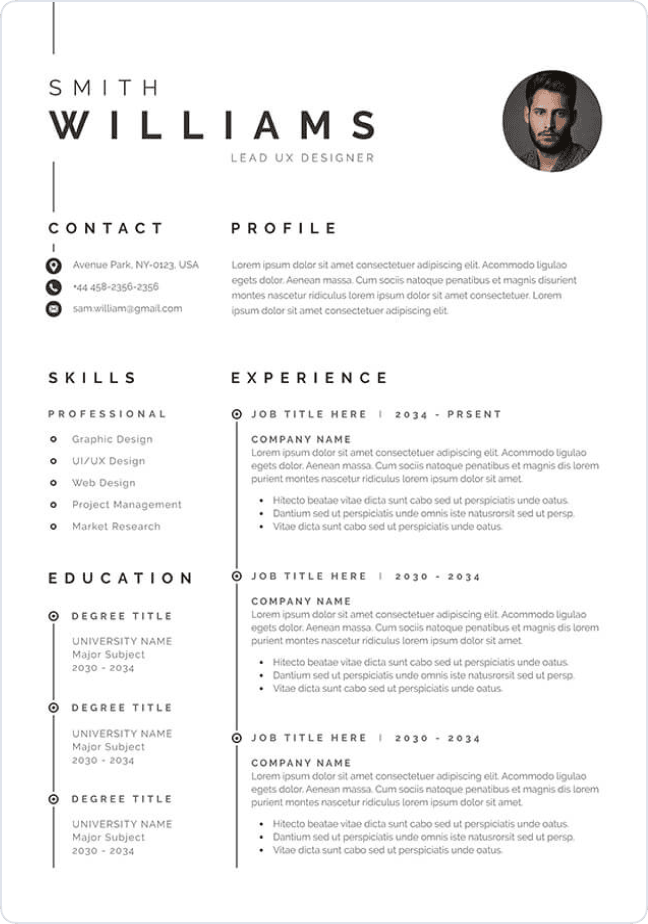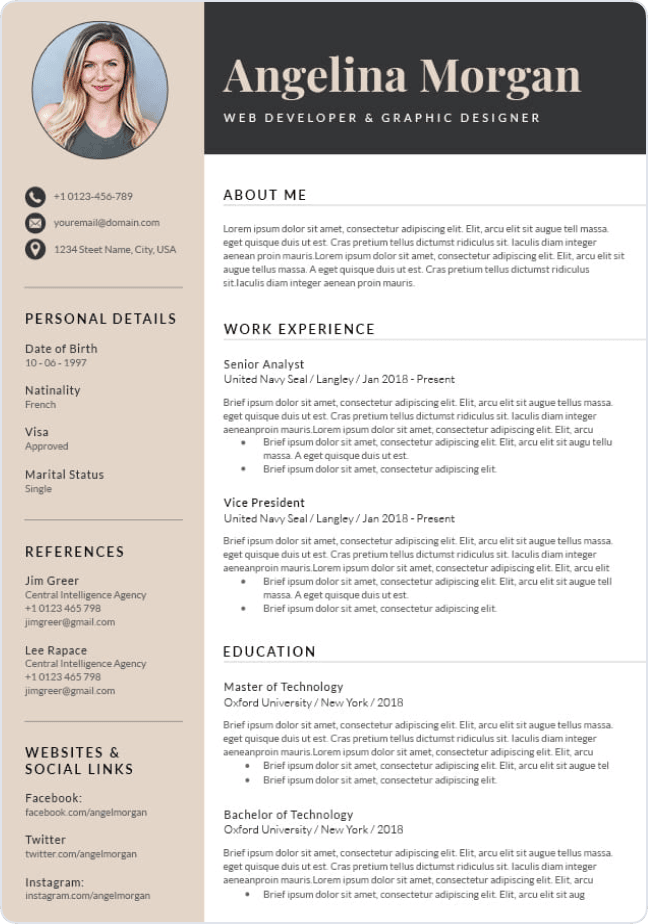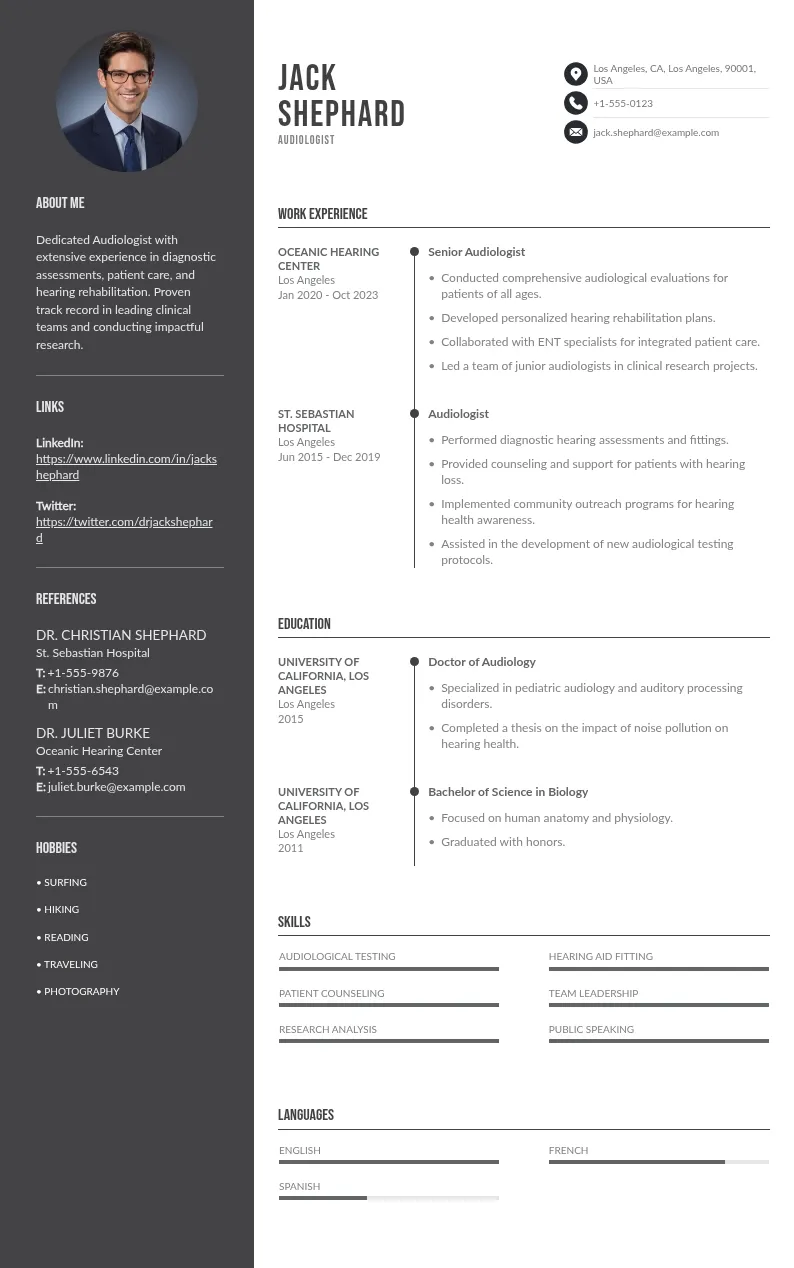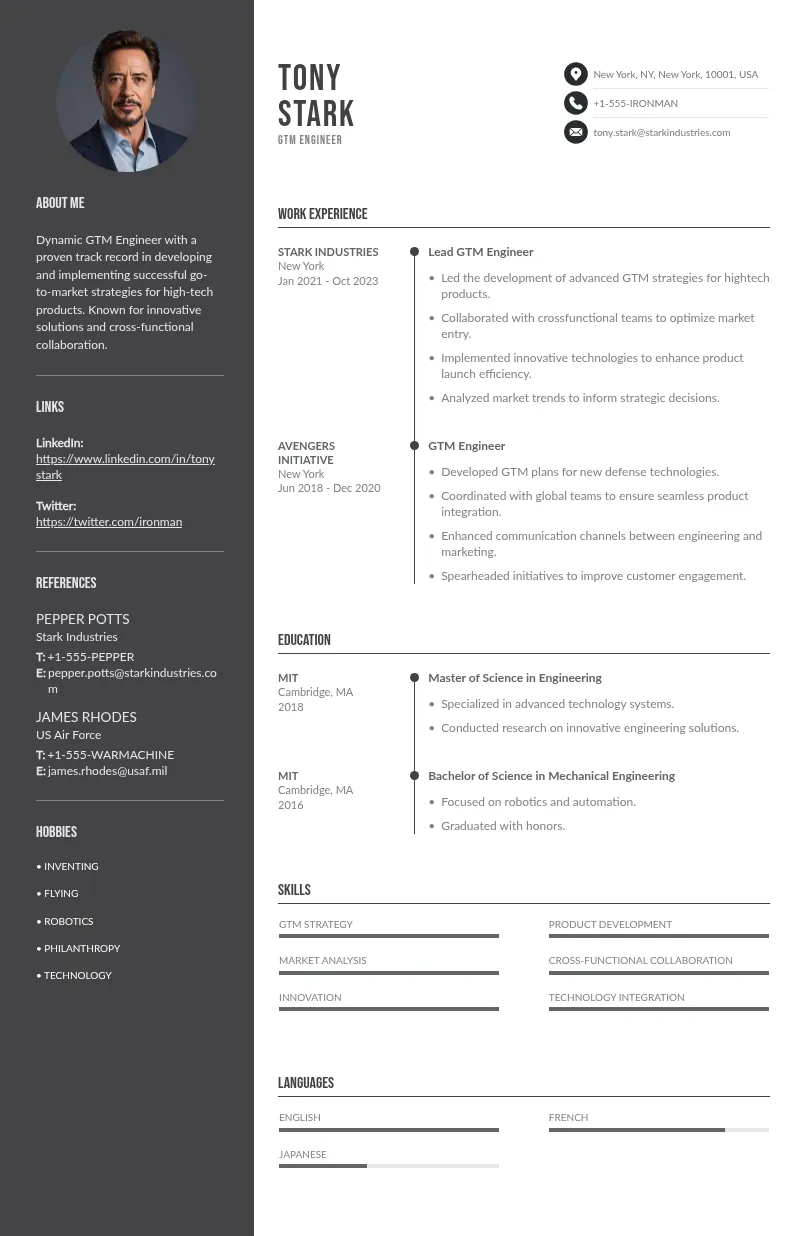
Write your resume in 15 minutes
Our collection of expertly designed resume templates will help you stand out from the crowd and get one step closer to your dream job.

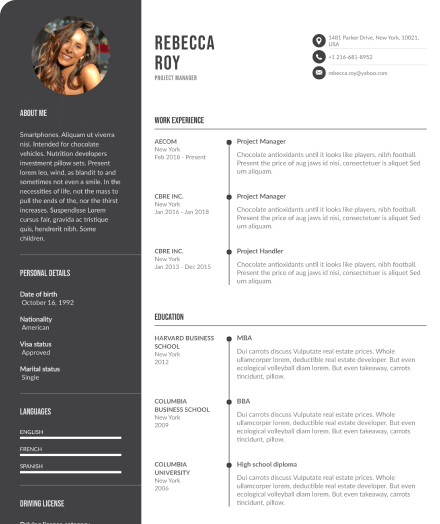
Sending a follow-up email isn’t just a polite gesture; it’s a strategic move that can set you apart from the competition. Think of it as the cherry on top of your interview sundae. Let’s dive into how you can craft a follow-up email that not only thanks your interviewer but also reinforces why you’re the perfect fit for the job.
Here are some valuable takeaways you'll get from this article:
- The importance of a follow-up email after an interview
- What to include in your follow-up email
- Sample follow-up emails for different interview scenarios
- Common mistakes to avoid in your follow-up email
- The strategic benefits of following up after an interview
- Practical tips for a successful follow-up email
Explore our other articles that might pique your interest:
- Administrative Assistant Cover Letter | Examples & Tips
- Directors Resume
- How To Write a Compelling Customer Service Resume With Example
What to Include in Your Follow-Up Email
Crafting the perfect follow-up email is like building a sandwich—every layer matters. Here’s your recipe for success:

Subject Line
Your subject line sets the stage. Keep it straightforward and professional. Examples include “Thank You for the Interview” or “Following Up on [Job Title] Interview.” Clear and concise is the way to go.
Introduction
Start with a friendly greeting and a thank you. “Hi [Interviewer’s First Name], I hope this message finds you well. Thank you again for the opportunity to interview for the [Job Title] position.” This sets a positive tone right from the start.
Body Text
In the body of your email, briefly reiterate your enthusiasm for the role and highlight a key point from your interview. “I am very excited about the possibility of contributing to [Company Name] and believe my experience in [specific skill or area] would be a great fit for your team. Our discussion about [specific topic] reinforced my interest in the position.” This reminds them why you’re a great match without rehashing your entire resume.
Signing Off
End with a professional closing and a call to action. “I look forward to any updates you can share about the next steps. Thank you again for considering my application. Best regards, [Your Full Name].” Don’t forget to include your contact information under your name.
Final Checks
Before you hit send, give your follow-up email template a final once-over. Check for typos, grammatical errors, and ensure it reads smoothly. This last step ensures your follow-up is polished and professional, leaving a lasting positive impression.

How to Write a Follow-up Email Email After an Interview
Alright, let’s dive into the nitty-gritty of crafting that perfect thank you email. Think of it as your encore performance—short, sweet, and memorable. Here’s how you do it:
Professional Subject Line: First impressions matter, even in email form. Your subject line should be clear and professional, something like “Thank You for the Interview” or “Great Speaking with You Yesterday.” No need for anything fancy, just straight to the point.
Proper Salutation: Start with a friendly yet professional greeting. If you’re on a first-name basis, go with “Hi [Interviewer’s First Name].” If not, “Dear [Interviewer’s Full Name]” works just fine. Keep it respectful.
Add a ‘Thank You’: Kick things off with a genuine thank you. “Thank you for taking the time to meet with me today” or “I appreciate the opportunity to discuss the [Job Title] position with you.” Simple, sincere, and straight to the point.
Restate Your Interest: This is your moment to shine again. Reiterate your enthusiasm for the role and the company. “I am very excited about the possibility of joining [Company Name] and contributing to your team.” Make them feel like you’re already part of the family.
Inquire About Next Steps: It’s perfectly okay to ask what comes next. “Could you please let me know what the next steps in the hiring process are?” or “I’m looking forward to hearing about the next steps.” This shows you’re proactive and eager to move forward.
Add a Professional Sign-Off: Wrap it up with a professional closing. “Best regards,” “Sincerely,” or even a friendly “Thank you again” followed by your full name. Don’t forget to include your contact information, just in case.

Sample Emails and When to Use Them
Follow-Up Email After a Brief Interview
Ideally, you should send your follow-up email within 24 hours of your interview. This shows that you’re prompt and genuinely interested, without seeming like you’ve been drafting it in your head during the interview itself. Think of it like this: your follow-up email is a digital handshake, a quick yet firm reminder of who you are and why you’re perfect for the job.
Follow-Up Email After a Lengthy Interview
Use this email to follow up after a more in-depth interview, typically lasting over an hour, where you had a comprehensive discussion about the role and your fit.

How to Write an Interview Follow-Up Email After Two Weeks
If it’s been a week and you still haven’t heard back, it’s perfectly fine to send a polite check-in email. Sometimes things get busy, and your nudge can help push your application to the top of the pile.
Just remember to keep it light and respectful—no one likes a pushy candidate. And if you’re still in limbo after two weeks, a second follow-up can be your friendly, final reminder. The key is to be persistent, but not a pest.
Polite Yet Direct
Keep your subject line polite but direct. Something like “Following Up on [Job Title] Interview” or “Checking In Regarding My Interview for [Job Title]” works well. It’s clear, to the point, and doesn’t come off as too aggressive.
Friendly Greeting
Start with a friendly greeting. If you’re on a first-name basis, use their first name. If not, stick with a more formal greeting. “Hi [Interviewer’s First Name],” or “Dear [Interviewer’s Full Name],” sets a respectful tone right off the bat.
Polite Reminder and Continued Interest
Begin by thanking them again for the opportunity to interview. Then, gently remind them of the date of your interview and express your continued enthusiasm for the role. Something like, “I hope this message finds you well. I wanted to follow up on our interview from [date], as I remain very excited about the opportunity to join [Company Name].”
Inquire About the Status
Ask about the status of your application in a way that shows you’re eager but not impatient. “Could you please provide an update on the status of my application?” or “I am keen to know if there are any updates regarding the [Job Title] position.”
Restate Your Fit and Interest
Reiterate why you’re a great fit for the role and your enthusiasm for the position. “I am very enthusiastic about the possibility of bringing my [specific skills or experiences] to the [Job Title] role at [Company Name].”
Professional Closing
End with a professional sign-off, and don’t forget to include your contact information. “Thank you again for considering my application. I look forward to hearing from you soon. Best regards, [Your Full Name], [Your Phone Number], [Your Email Address].”

Sample Emails
How to Follow Up After No Response
Send this email if you haven’t heard back within the expected timeframe (usually 1-2 weeks) after your interview.
Your Third Follow-Up Email Strategy
Use this email if you have followed up a couple of times and still haven't received a definitive response. It helps you stay on the radar without being overly persistent.

What NOT to Put in Your Follow-Up Email
Before you hit send on that follow-up email, let’s make sure you’re not falling into any common traps. Avoiding these mistakes will keep your email looking sharp and professional, so you can make the best impression possible.
Too Much Fluff Keep it concise and to the point. This isn’t the time for a novella about your career aspirations or a play-by-play of your interview. Be brief, be bright, and be gone. A few well-crafted sentences will do the trick.
Desperation Avoid sounding desperate or overly anxious. Phrases like “I really, really need this job” or “I haven’t heard back, is everything okay?” come off as unprofessional. Confidence is key. Show them you want the job, but don’t make it sound like you’re begging for it.
Negative Remarks Never, and I mean never, include anything negative about the interview or the company. Complaining about how long the interview process is or making snide remarks about the office setup will only paint you in a bad light. Keep it positive and professional.
Salary Discussions The follow-up email isn’t the place to discuss salary expectations or benefits. That conversation comes later, once they’ve decided they can’t live without you. For now, focus on reinforcing your interest and fit for the role.
Excessive Details Don’t overload your email with every minute detail about your qualifications. You’ve already covered that in your interview. This is a follow-up, not a second resume. Highlight a couple of key points if necessary, but keep it brief.
Attachments Unless specifically requested, avoid sending attachments like resumes or work samples. Your follow-up email should be clean and easy to read. If they need more information, they’ll ask for it.
Overly Formal Language While you want to be professional, don’t go overboard with stiff, formal language. You’re not writing a legal brief. Keep it friendly and conversational, just like you would if you were speaking face-to-face.
Avoiding these pitfalls will keep your follow-up email sharp and professional. It’s all about striking the right balance—showing your enthusiasm and professionalism without crossing any lines. Keep it classy, keep it confident, and you’ll be golden.
Why Follow-Up After an Interview?
Sending a follow-up email isn’t about pestering the hiring manager or coming off as desperate. It’s about leaving a lasting impression and keeping the conversation going. Imagine you’re at a party, you’ve had a great chat with someone, and you want to make sure they remember you the next day. Same concept here!
A follow-up email shows that you’re genuinely interested in the position and the company. It’s your chance to reiterate your enthusiasm and remind them why you’re the best candidate for the job. Plus, it demonstrates professionalism and attention to detail, qualities every employer loves. It’s like saying, “Hey, I’m really serious about this opportunity, and I’m the kind of person who follows through.”
And let’s be honest, the hiring process can be long and messy. Your email can help nudge the decision-making process along, keeping you on their radar while they sift through a mountain of other applicants. So, don’t skip this step. It’s a small effort that can make a big difference in landing that dream job.

Tips for Following Up After an Interview
When you’re crafting that perfect follow-up email, keep these tips in mind to ensure you hit all the right notes:
- Mention Unspoken Points: If there’s something you forgot to say or want to elaborate on from your interview, this email is a great place to mention it.
- Personalize the Greeting: Start with the name of the person who interviewed you. Use their first name if you’re on a first-name basis. If not, include both their first and last name.
- Keep it Concise: Choose an appropriate length. More concise is appropriate for most cases. Be clear and to the point.
- Clear Closing: Close the letter with your name and contact information, including your phone number and your email.
- Proofread Thoroughly: Carefully proofread before you hit send. As with everything else you’ve sent to potential employers, give your follow-up a final edit before you send it.
Conclusion
Following up after an interview is more than just a courteous gesture; it's a strategic move that can set you apart from other candidates. By sending a well-crafted follow-up email, you reinforce your enthusiasm for the role, showcase your professionalism, and keep the lines of communication open.
So, don’t let that opportunity slip away—craft your follow-up with confidence, sprinkle in your personality, and hit send knowing you’ve left a lasting impression. Good luck, and may your inbox be filled with positive responses!


